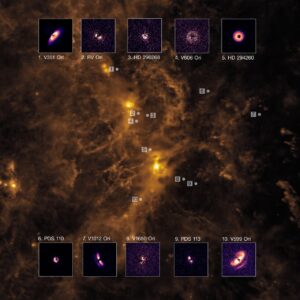
One of our recurring topics is “planet formation is not well understood”, and a trio of new papers is making it clear why planet formation continues to not be well understood. Put simply: The universe likes to create solar systems more diverse than an entire planet’s worth of sci-fi writers are capable of imagining.
Published in Astronomy and Astrophysics, these papers from the DESTINYS project look at solar system formation around 86 stars across three clusters — the Chamaeleon I and Taurus star-forming regions, which are both about 600 light-years away, and the significantly larger Orion star-forming region, about 1,600 light-years away.
The DESTINYS Project, which is a clever acronym of Disk Evolution Study Through Imaging of Nearby Young Stars, used the super high-resolution SPHERE instrument on the Very Large Telescope in Chile, which allowed them to make our planet-forming disk details in these clusters at the level of being able to make out the asymmetries and structures associated with large planets. They can also readily measure the size of disks and more.
The different environments allow different kinds of stars and solar systems to form. For instance, it was already well known that Orion, which has more mass to form stars, is forming larger stars more often.
Across these 86 systems, they spotted a few trends: many faint disks are young — just two million years old or less in the Chamaeleon I systems. Multi-star systems are less likely to have large planet-forming disks. In the Taurus system, they note that systems in the core of the cluster are smaller and fainter, while systems further out include both faint disks and bright disks interacting with their surroundings.
Both glorious and frustrating, these systems came in all sizes, and for every trend they found, they also found exceptions. This beautiful data set shows us our planet-forming models need to take into account the density of the surrounding star-forming region, the history of interactions the system experienced, and the elements of chaos theory and statistics that go into explaining when two dust grains will stick and when they will bounce apart. In modeling our solar system and others, we will need to develop algorithms that create worlds like ours on the regular but also leave space for every other possibility to exist. Whimsy isn’t a scientific characteristic – at least not in astronomy – but in looking at these images and trying to grasp what all is possible, I just keep imagining Gene Wilder’s Willy Wonka singing “Pure Imagination” as we imagine “traveling to the worlds of all creation // where we’ll see things defy // explanation.”

While the DESTINYS team is studying the diversity of ways that disks get their start, another team, using the JWST, is working to understand how a planet-forming disk transitions into a disk of planets.
In a new paper appearing in The Astronomical Journal and led by Naman S. Bajaj, researchers looked in detail at the T Chamaeleon system, a transition system with a 30-AU gap in the center of its disk; this is a gap that in our solar system would reach from the Sun out to Neptune. The gap shows where dust is already getting removed from the system as planet formation comes to a halt. The system also has gases appearing to be dispersed by a stellar wind. Specifically, they can observe a variety of noble gases – gases that don’t like to bond into things and are less likely to get tied up in forming planets – moving out of the disk. Combined, this data paints a bigger picture of a solar system that is pushing out the stuff that forms planets, and moving forward with whatever worlds have already finished forming.
This star was picked for detailed observations for many reasons, including a long baseline of data over time. Early data from the Very Large Telescope hinted at the gas dispersal and provided comparison data for today’s new images. These data sets allow them to see the dying disk change as before our telescopes, with dust getting dispersed from the system in noticeable ways across the decades. According to team member Chengyan Xie, “We might be able to witness the dispersal of all the dust mass in T Cha’s inner disk within our lifetime!”
This is a new phase in planet formation for our models to understand. As the story goes, gas collapses into a disk, the disk forms planets, the star blows out whatever gas and dust remains as it finishes its formation process, and then… things happen. In our own solar system, there was an early period of gravitational interactions flying worlds to and fro. Understanding that next, mystery step? Our telescopes aren’t able to help with that yet, but we still have plenty of work left to do to understand how planet formation starts and ends. T Cha is just one star, and if formation teaches us anything, it’s that two stars rarely look alike, and we still need a lot more data.
When more data comes out, we’ll bring it to you here on Escape Velocity Space News.
